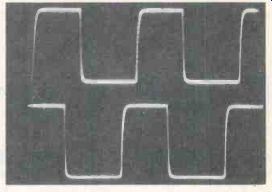Each report about an item of electronic test equipment is based on examination and operation of the device in the ELECTRONIC SERVICING laboratory. Personal observations about the performance, and details of new and useful features are spotlighted along with tips about using the equipment for best results.
By Carl Babcoke

----- All four models of the new Hitachi line of scopes have
similar appearance and features. This is the 15MHz model V-152.
---- Top trace shows a 3.58MHz color carrier at 0.2uS sweep on the Hitachi model V-302 30MHz scope. Bottom trace has two horizontal lines of color-bar chroma waveforms viewed at 10uS sweep.
-----Excellent detail without ringing or overshoot is shown by this dual-trace view of composite video and horizontal-sweep pulses.

------- These waveforms show the effect of signal delay lines
in Hitachi scope models V-302 and V-301. Top waveform shows a 200kHz
series of square waves with the initial leading edge displayed. When the
signal-delay line was bypassed by locking from the same signal applied
to the external-trigger input jack, the leading edge and part of the first
peak are missing.
A new line of four oscilloscopes has been released by Hitachi Denshi America. These models are virtually identical. Therefore, the top-of-the-line model V-302 is de scribed here as typical of all four, except for the stated exceptions.
General features
Wide bandwidth, high sensitivity and several advanced features qualify these versatile scopes for adjustments and analysis of radios, audio systems, TVs, videocassette recorders, industrial systems, computers and other products.
One unusual feature is the choice of two bandwidths. When the 5MHz bandwidth is selected, the maximum vertical gain is 1mV.
Horizontal sweep
Sweep times extend from 0.2S/div to 0.2uS/div in 19 calibrated ranges.
An uncalibrated variable-time control allows selection of slower-in-be tween values. Pulling out the horizontal positioning knob expands the sweep width to 10 times normal (X10 mag), which provides a fast sweep equivalent to 100nS/div.
The mode switch selects normal triggering (no sweep unless locked), automatic triggering (has sweep even without signal) and both polarities of TV sync. An internal sync separator provides TV-type sync pulses for solid locking of video waveforms (an important feature since video otherwise is difficult to lock).
Adjustment of the source switch allows the triggering signal to be taken from channel 1, channel 2 (if dual-tract), 60Hz line or the external-triggering input jack. An adjustable level control also provides triggering on positive or negative slopes.
Vertical channels
Vertical frequency response of model V-302 is rated within-3dB from dc to 30MHz. Sensitivity between 5mV/div and 5V/div is available in 10 fixed steps. Also, continuous height variation is possible by an uncalibrated control.
The 0.005V (5mV/div) maximum sensitivity is higher than that of older models, and it can be increased at the expense of reduced bandwidth. With an X10 probe and the graticule of eight divisions, the maximum measurable input is limited to 400VPP.
For those times when extra sensitivity is needed, the vertical centering knob is pulled out. Maximum sensitivity increases to 1-mV/div and the upper response is decreased to 5MHz.
A 5-position mode switch provides display of: channel 1 waveform; channel 2; both channels in dual-trace; addition of both channels; and the difference between both channels.
Each vertical channel has a sliding switch for ac coupling, dc coupling or a grounded input.
Switching between alternate and chopped display of two traces is accomplished automatically by the setting of the time/div sweep control.
Both 30MHz models have signal-delay lines that allow the leading edges of pulses to be viewed. This is a good feature that is imperative for digital waveforms.
CRT and calibration
Each 5-inch CRT has blue traces, black lines for graticule calibration and no provision for illumination. Ordinary room light is usually adequate for taking readings from the screen.
In addition to the customary trace intensity and focus controls, a screwdriver-adjustable trace rotation control is provided. This control can tilt the horizontal traces as needed. If a local magnetic field moves the traces so they no longer are parallel with the graticule lines, a simple adjustment will level the traces.
Probes
Probes supplies with these Hitachi scopes provide only an X10 function that reduces the input amplitude by a factor of 10 while it provides low-capacitance operation. Elimination of the direct (or X1) function is not a disadvantage because it is offset by the high vertical sensitivity. And without the X1 function, the probes are smaller and less prone to problems. The cable has a small diameter and is very flexible.
For frequency compensation, the hook probe is attached to the calibration waveform terminal at the panel upper-right corner, then a trimmer (inside the cable's BNC plug) is adjusted for flat-top square waves.
Comments
Model V-151 is the single-trace 15MHz version. Model V-152 is similar except for the dual-trace feature. Both have about 2kV acceleration voltage.
Model V-301 is identical to the V-302 just described except it has one vertical channel for single-trace operation. Both are rated at 30MHz vertical response, have about 4kV acceleration voltage and feature a vertical-signal-delay line.
Each year the need increases for better scopes and other items of test equipment. Therefore, it is recommended for the purchase of any scope that the model selected have more features and better specifications than those required at the present time. This will prevent early obsolescence.
The sample model V-302 per formed very well in the Test Lab where it produced sharp stable waveforms of color-TV signals. It is recommended for troubleshooting of home-entertainment, industrial, radio-communication and digital equipment.
Also see: